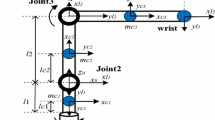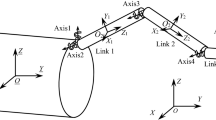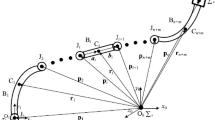Abstract
The current research of robots is mainly developing in lightweight, fast speed and large load. The characteristics of flexible robots are mainly reflected in flexible joints and links. However, flexible joints are often assumed to be simply linear. Since the joint of the planetary reducer also needs to consider the flexible deformation and nonlinearity of the structure, this assumption is not applicable to the assumption of this joint. Therefore, considering coupling properties of the more accurate structure and friction, the joints and the flexible links, a more accurate dynamic model of the flexible robot is established. Furthermore, the accuracy of motion and positioning for the flexible robot under the influence of many factors is analyzed. The research is of great significance for flexible robot control. Firstly, the structure of the two-stage planetary gear reducer is analyzed. Using Newton's Euler and force balance principles, the dynamic model of its joint reducer was constructed. Secondly, taking the Euler–Bernoulli beam as the object, using the Lagrange method and the structural damping formula, the coupling dynamic model of the flexible robot is established. Based on the virtual work and variational principles, the input matrix is further modified by friction. Finally, Using MATLAB and the experiment platform, the validity of the coupling dynamics is verified. And then, taking the flexible deformation, the clearance, and friction of the reducer as the influencing factors, the influence characteristics of the flexible robot are analyzed.
















Similar content being viewed by others
Code or Data Availability
Not applicable.
References
Senfelds, A.: Analysis of motion modelling approaches for industrial robot applications. In: 2019 IEEE 7th IEEE Workshop on Advances in Information, Electronic and Electrical Engineering (AIEEE) (2019)
Mekid, S.; Kwon, O.J.: Nervous materials: a new approach for better control, reliability and safety of structures. Sci. Adv. Mater. 1(3), 276–285 (2009)
Yang, L.H.: Dynamic modeling and dynamic characteristic analysis of medical flexible manipulator coupling. Lanzhou University of Technology Press, Lanzhou (2020)
Mekid, S.; Shang., M.: Concept of dependent joints in functional reconfigurable robots. J. Eng. Des. Techn. 13(3), 401–413 (2015)
Yang, T.F.; Yan, S.Z.; Ma, W.: Joint dynamic analysis of space manipulator with planetary gear train transmission. Robotica 34(5), 1042–1058 (2016)
Yan, S.; Zhang, X.W.L.: A comprehensive model for 3D revolute joints with clearances in mechanical systems. Nonlinear Dyn 80(12), 309–328 (2015)
He, S.W.: Dynamic Modeling and Control Strategy of Space Manipulator Joints Considering Planetary Gear Gaps. Beijing University of Posts and Telecommunications Press, Beijing (2012)
Pan, B.; Sun, J.; Yu, D.Y.: Fault-tolerant joint design and control for large-scale space manipulator. J. Mech. Trans. 9(2), 1–5 (2010)
Yang, T.F.; Gu, Y.X.; Yan, S.Z.: Dynamic modeling of large-scale and performance analysis. 2003 Symposium on space optics and mechatronics. Chin. Soc. Space Sci. 2013, 213–219 (2013)
Sun, X.M.; Lu, J.W.; Chen, H.; Xu, Y.: Dynamic modeling and analysis of robot arm with consideration of clearance in gear reducer. J. Mech. Eng. 49(15), 16–21 (2014)
Khalid, A.; Mekid, S.: Intelligent spherical joints based tri-actuated spatial parallel manipulator for precision applications. Robot Comput. Integrat. Manuf. 54, 173–184 (2018)
Li, R.J.; Liu, H.Z.; Li, P.F.: Dynamics modeling of 2 dof five-bar mechanism in considering dissipation of joint. J Agr Mach. 39(12), 157–161x (2008)
Alinalbu, S.; Gerd, H.: A globally stable state feedback controller for flexible joint robots. Adv. Robot. 15(8), 799–814 (2001)
Moreno, J.; Kelly, R.: Pose regulation of robot manipulators with dynamic friction compensation. In: Proceedings of the 44th IEEE Conference on Decision and Control, and the European Control Conference, NewYork, pp. 4368–4372 (2005)
He, Y.; Mei, J.P.; Fang, Z.W.; Xie, S.L.; Sun, Y.D.: Research of energy consuming of a single joint servo system of robot. Des. Res. 9, 84–90 (2017)
Zhang, C.Y.: Simulation analysis of space manipulator clearance and friction dynamics. Yanshan University (2015)
Liu, F.C.; Liu, C.; Feng, Q.L.: Influence of friction under gravity on motion control of space manipulator. High Technol. Commun. 24(1), 65–71 (2014)
Bean, B.; Yue, X.K.: Analysis and control of collision dynamics in space capture with friction considerations. China space Sci. Tech. 38(1), 54–62 (2018)
Wei, K.: Dynamic Analysis of Space Flexible Manipulator. Harbin Institute of Technology Press, Harbin (2008)
Sharmila, K.; Jayantha, K.; Garth, P.: Control of a space robot with flexible manipulator using generalized decoupling technique. In: 2018 2nd International Conference on Robotics and Automation Sciences, New York, IEEE, pp. 112−116 (2018)
Vakil, M.; Fotouhi, R.; Nikiforuk, P.N.: A study of the free vibration of flexible-link flexible joint manipulators. Proc. Inst. Mech. Eng. 225(6), 1361–1371 (2011)
Lee, H.H.: New dynamic modeling of flexible-link robots. J. Dyn. Syst. Measure Cont 127(2), 307–309 (2005)
Tokhi, M.; Mohamed, Z.; Azad, A.: Finite difference and finite element approaches to dynamic modelling of a flexible manipulator. J. syst. Con. Eng. 8, 21–25 (1997)
Zhao, Y.; Ruan, C.M.: Second order Theoretical precision modeling and experimental research of flexible Manipulator with rigid and flexible coupling. China Mech. Eng. 29(2), 205–210 (2018)
Chen, Z.: Research on Modeling and Control of Flexible Manipulator. Xi dian University Press, Xi dian (2012)
Xia, D.: Low frequency Vibration control and experimental study of flexible arm with large load. Beijing University of Posts and Telecommunications Press, Beijing (2013)
Tang, G.C.; Jin, G.G.; Liu, Y.: Dynamic modeling and characteristics of flexible manipulator. Mech. Sci. Tech. 28(8), 1031–1034 (2009)
Guo, W.Z.; Gao, F.; Mekid, S.: A new analysis of work space performances and orientation capability for 3-dof planar manipulators. Int. J. Robotics Autom. 25(2), 89–101 (2010)
Chen, Y.Z.; Zhang, D.G.; Li, L.: Absolute node coordinate method based on meshless radial basis point Interpolation for plane slender beams. J. Vib. Eng. 31(02), 245–254 (2018)
Fang, J.S.; Zhang, D.G.: A high order dynamic model for rotating thin plates and frequency steering. J. Mech. 48(01), 173–180 (2016)
Li, L.; Zhang, D.G.; Guo, Y.B.: Study on dynamic characteristics of rigid-flexible coupling functionally gradient beam system in variable temperature field. J. Vib. Eng. 30(01), 9–19 (2017)
Korayem, M.H.; Dehkordi, S.F.: Derivation of motion equation for mobile manipulator with viscoelastic links and revolute–prismatic flexible joints via recursive Gibbs-Appell formulations. Robot. Auto Syst. 2018(103), 175–198 (2018)
Huang, Y.G.; Deng, Z.C.: Dynamic analysis of rigid flexible coupling system of central rigid body - wedge beam - particle. J. Com. Mech. 49(01), 14–19 (2007)
Chen, S.J.; Zhang, D.G.: Study on dynamic characteristics of central rigid body-variable section beam system. J. Mech. 43(04), 790–794 (2011)
Du, X.B.; Chu, A.M.; Phan, B.K.: Dynamic analysis of two-link flexible manipulator considering the link length ratio and the payload. Viet. J. Mech. 39(04), 303–313 (2017)
Buffinton, K.W.: Dynamics of elastic manipulators with prismatic joints. ASME J. Dyn. Syst. Measure Con. 112(4), 41–49 (1992)
Chen, S.J.; Zhang, D.G.; Hong, J.Z.: A high order rigid-Flexible coupling dynamic model for large deformation rotating flexible beam. J. Mech. 45(02), 251–256 (2013)
Funding
This study is supported by National Natural Science Foundation of China (Grant Nos. 51505381, 51275423).
Author information
Authors and Affiliations
Contributions
ZHY provides the research focus of the manuscript and gives the overall idea of the analysis of the problem. He took the lead in setting up the experimental platform. The whole manuscript was reviewed and improved; FLZ puts forward the theory innovation of the whole paper and organizes the structure of the whole paper. And he used software to compare simulation and experiment, thereafter organized the complete paper work. At last, all authors read and approved the final manuscript.
Corresponding author
Ethics declarations
Conflict of interest
The authors declare that they have no conflict of interest.
Ethics Approval and Consent to Participate
All applicable institutional and national guidelines were followed.
Consent for Publication
All authors confirm that: The research done in this paper has not been published before. This is not considered for publication anywhere else. All coauthors approve the publication of this information.
Appendix
Appendix
Rights and permissions
About this article
Cite this article
Zhang, F., Yuan, Z. The Study of Coupling Dynamics Modeling and Characteristic Analysis for Flexible Robots with Nonlinear and Frictional Joints. Arab J Sci Eng 47, 15347–15363 (2022). https://doi.org/10.1007/s13369-022-06581-3
Received:
Accepted:
Published:
Issue Date:
DOI: https://doi.org/10.1007/s13369-022-06581-3




